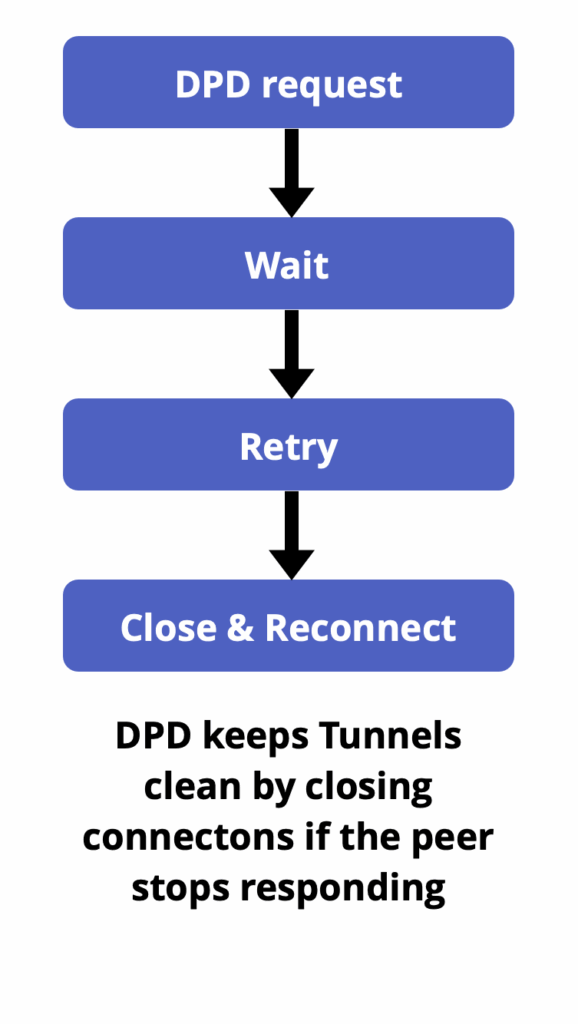VPN issues often go unnoticed until productivity takes a hit, Dead Peer Detection (DPD) can help prevent that
One of the most common VPN issues is when one side of the connection silently goes offline. The tunnel may appear active but no data is getting through. This leads to real-world issues like disconnected file shares, stalled cloud syncs, dropped applications, or interrupted video calls. Without a reliable way to detect these failures, productivity suffers.
That’s where DPD (Dead Peer Detection) comes in. It’s a lightweight mechanism used by VPN clients and gateways to confirm that the peer on the other end is still responsive. If no reply is received within a defined interval, the VPN connection is safely closed and can be restarted, avoiding silent failures and long wait times.
VPN Tracker supports DPD by default and enhances it with intelligent behavior tailored for different tunnel types. Whether you’re on a shaky WiFi connection or switching networks, VPN Tracker helps ensure your connection remains reliable and responsive.
Without DPD, VPN tunnels may appear active even when one side is unreachable.
What Is Dead Peer Detection (DPD)?
Dead Peer Detection, or DPD, is a VPN mechanism designed to identify when the peer at the other end of a VPN tunnel is no longer responding. It acts as a safeguard against silent tunnel failures — situations where a VPN connection appears active but the underlying connection has already been lost.
It works by sending lightweight "Are you there?" messages (often referred to as keep-alive or DPD request packets) at regular intervals. If the peer does not respond after a set number of retries, the tunnel is marked as inactive. The connection can then be safely closed and re-established instead of lingering in a broken state.
For IKEv1 VPN, the protocol is defined in RFC 3706 and for IKEv2, in RFC 5996, and is supported by most modern VPN devices and clients. It was originally introduced to solve issues that arise in IPsec tunnels, especially in environments where connections may drop unexpectedly, such as mobile work, poor WiFi, or networks using NAT or firewalls with stateful inspection.
Here’s a simple example: Imagine your laptop is connected to the office VPN while working from a cafe. The WiFi briefly drops, but your VPN app still shows "connected." Meanwhile, your files stop syncing and your video call freezes. With detection enabled, your VPN client quickly notices the other side is not responding, cleanly closes the broken tunnel, and automatically reconnects once your internet is back — all without you needing to do anything.
Why DPD Matters for VPN Stability
Without peer detection, VPN tunnels can silently fail without any clear indication. This often happens when one side of the connection drops unexpectedly due to unstable internet, network changes, or NAT timeouts. The VPN software may still show an active connection, even though no data is getting through.
For users, this leads to frustrating and confusing issues: file shares disconnect, cloud syncs stall, apps time out, and video calls freeze without explanation. Because the tunnel appears to be up, the system does not always try to reconnect on its own.
This kind of issue is exactly what DPD was designed to address. If the remote side becomes unresponsive, the connection is marked as inactive and can be safely restarted. This ensures that the VPN does not get stuck in a broken state and helps users get back to work faster.
Especially in mobile or home office environments, where WiFi quality or network conditions often change, this mechanism is essential to keep VPN connections stable and predictable.
 How Dead Peer Detection Works
How Dead Peer Detection Works
Dead Peer Detection (DPD) is a mechanism used to check whether the other side of a VPN tunnel is still reachable. The VPN client or gateway sends a small message — often called a DPD request or keep-alive ping — asking the peer if it is still available. If the peer responds within the expected time, the VPN connection is considered healthy.
If no response is received, the system waits a defined interval and retries several times, depending on the configured settings. For example, if DPD is set to check every 10 seconds with 5 retries, the peer has about 50 seconds to respond. If all retries fail, the peer is marked as unreachable and the VPN tunnel is either closed or renegotiated.
VPN Tracker goes one step further: it also monitors regular network traffic. This means that if a single DPD packet is lost but normal data traffic is still flowing, the connection will not be interrupted. This approach avoids unnecessary disconnects and provides more stable VPN sessions.
Dead Peer Detection is especially useful when no other traffic is passing through the tunnel. Without it, VPN software would have no way of knowing that the connection has failed until the user tries to send data — which may be too late for real-time applications or critical file transfers. By using DPD, VPN Tracker can detect connection issues early, react intelligently, and recover quickly, ensuring a seamless VPN experience on Mac.
DPD vs. IKE Keep-Alive: Key Differences
Dead Peer Detection and IKE Keep-Alive are often mentioned together, but they serve different purposes and should not be used at the same time.
DPD is a widely supported industry standard, and as mentioned above, is defined in RFC 3706 (IKEv1) and RFC 5996 (IKEv2). It checks if the VPN peer is still responsive by sending dedicated request messages and waiting for replies. If no response is received after several retries, the connection is considered dead and is removed.
IKE Keep-Alive, on the other hand, is often a vendor-specific feature. It keeps the tunnel open by sending empty or minimal packets at regular intervals, mainly to prevent idle timeouts on NAT routers or firewalls. It does not necessarily detect if the peer is still available, and it is not always supported across different devices.
If both features are enabled at the same time, they can interfere with each other. For example, one may trigger a rekey or renegotiation while the other still considers the tunnel active. This can result in unstable behavior, with tunnels disconnecting and reconnecting in a loop.
Best practice: Use either DPD or IKE Keep-Alive — not both. For most modern VPN setups, DPD is the more reliable and flexible option, especially when connecting between different types of devices.
VPN Tracker 365 in action: Monitor tunnel health and stay connected with InfiniConnect.
How VPN Tracker Implements DPD
VPN Tracker supports this mechanism as a built-in feature and offers two key options for fine-tuning how it behaves during a VPN connection. DPD is primarily used with IPsec-based VPN protocols, including IKEv1 and IKEv2 but also works with all other protocols in VPN Tracker, excluding WireGuard, which in general does not support DPD.
Keep Alive is available for IKEv1, IKEv2, WireGuard and OpenVPN connections.
If you are using an IPsec connection profile in VPN Tracker, Dead Peer Detection will be available as an option and is recommended in most cases.
- Advertise as Dead Peer Detection Capable
When this option is enabled, VPN Tracker tells the VPN gateway that it supports DPD. This lets the gateway know that it can safely use the feature with your client and expect responses. This setting is safe to use with almost all modern VPN gateways and should be left on by default. - Perform Active Dead Peer Detection
In some cases, the VPN gateway may not send DPD requests itself. If this option is enabled, VPN Tracker will actively send requests at a user-defined interval. If the peer does not respond, VPN Tracker will assume the connection is no longer valid and will disconnect or attempt to reconnect. - To avoid false disconnects, VPN Tracker only activates DPD after it has received at least one ping from the remote gateway. This ensures the system does not close a connection too early, especially right after establishing a tunnel.
 Best Practices and Device Compatibility
Best Practices and Device Compatibility
Recommended Settings
Avoid Tunnel Flapping
Device Compatibility
VPN Tracker supports this mechanism with all major IPsec-compatible devices, including:
- Cisco ASA and Cisco routers
- Fortinet FortiGate
- SonicWall firewalls
- WatchGuard Firebox
- Ubiquiti and UniFi routers
- Lancom VPN gateways
- Palo Alto firewalls
Conclusion: Smarter VPNs Start with DPD
This feature is a small but powerful addition that keeps VPN connections stable and responsive. By automatically detecting when the peer on the other end is no longer available, it prevents silent disconnects, stalled apps, and wasted time.Whether you are working remotely, managing clients, or supporting a team, this detection mechanism helps ensure your VPN connections stay clean and reliable. With built-in support and intelligent behavior tailored to real-world scenarios, VPN Tracker gives you a smarter way to stay connected.
Want to see how it works in your setup? Try VPN Tracker today and experience more reliable VPN connections with less downtime.
Dead Peer Detection and Always-On VPN: The Best of Both Worlds
- Stale tunnels are safely closed and re-established
- InfiniConnect automatically reconnects your VPN when the network changes
- Works with IPsec tunnels on all major VPN gateways
- Fully integrated in VPN Tracker Executive, Pro, VIP, and Consultant plans